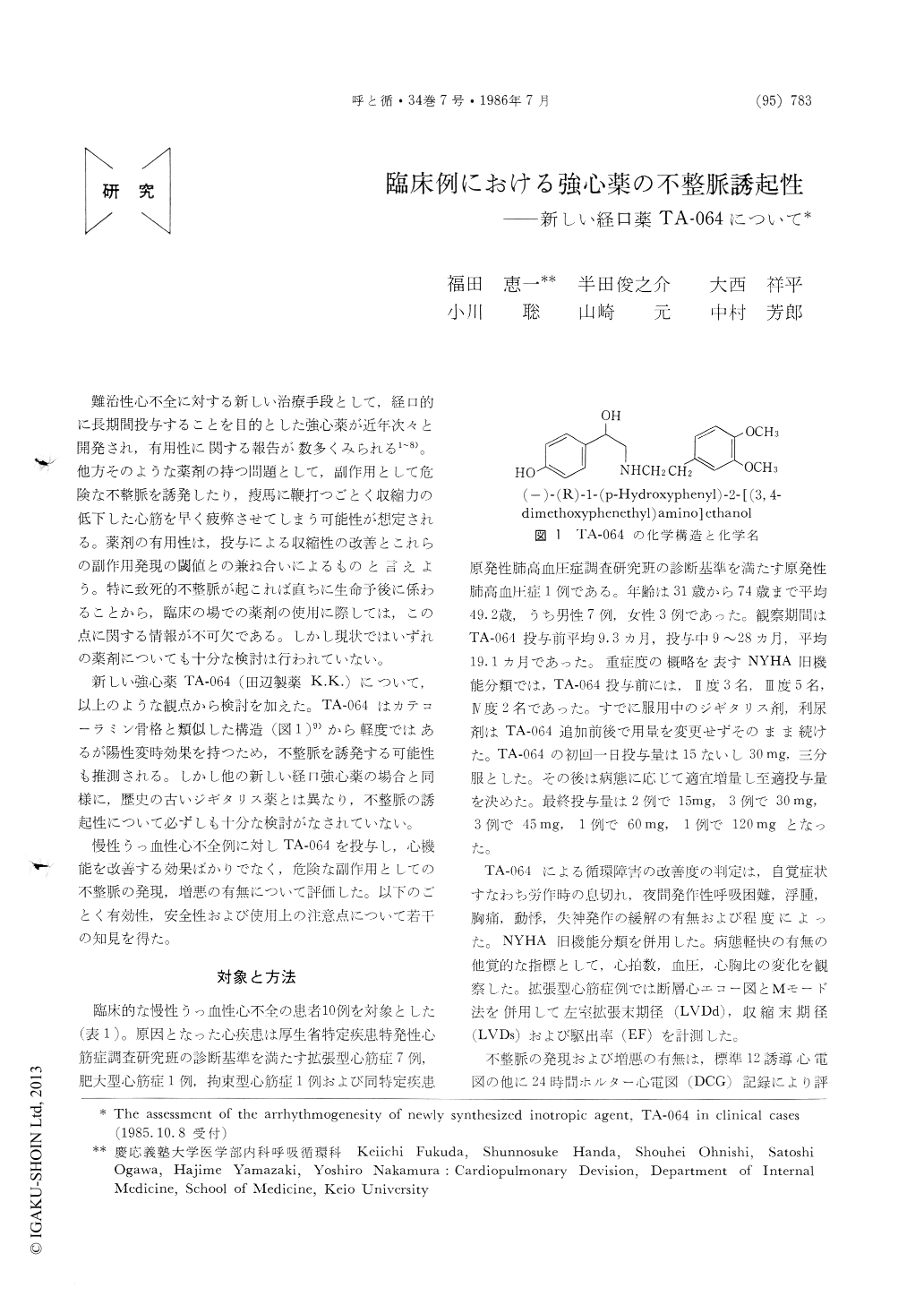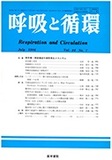Japanese
English
- 有料閲覧
- Abstract 文献概要
- 1ページ目 Look Inside
難治性心不全に対する新しい治療手段として,経口的に長期間投与することを目的とした強心薬が近年次々と開発され,有用性に関する報告が数多くみられる1〜8)。他方そのような薬剤の持つ問題として,副作用として危険な不整脈を誘発したり,痩馬に鞭打つごとく収縮力の低下した心筋を早く疲弊させてしまう可能性が想定される。薬剤の有用性は,投与による収縮性の改善とこれらの副作用発現の閾値との兼ね合いによるものと言えよう。特に致死的不整脈が起これば直ちに生命予後に係わることから,臨床の場での薬剤の使用に際しては,この点に関する情報が不可欠である。しかし現状ではいずれの薬剤についても十分な検討は行われていない。
新しい強心薬TA−064(田辺製薬K.K.)について,以上のような観点から検討を加えた。TA−064はカテコーラミン骨格と類似した構造(図1)9)から軽度ではあるが陽性変時効果を持つため,不整脈を誘発する可能性も推測される。しかし他の新しい経口強心薬の場合と同様に,歴史の古いジギタリス薬とは異なり,不整脈の誘起性について必ずしも十分な検討がなされていない。
Recent studies on new inotropic agents reported relief of symptoms acutely in patients with congestive heart failure, associated with hemodynamic improvement. It was not known that these agents could promise a better prognosis chronically. These agents have chro-notropic effects and may develop lethal arrhythmia as a side effect.
We, therefore, evaluated possible arrhythm genesity of a new inotropic agent, TA-064 (Tanabe Seiyaku Co.,) in clinical cases. TA-064 is a synthesized, non-catecho-lamine and non-glycosidic agent which was developed in Japan. The study group consisted of 10 patients, included 7 men and 3 women with average age of 49.2 years old (range of 31 and 74). Of these 10. there were 7 patients with idiopathic dilated cardiomyo-pathy (DCM), 1 with hypertrophic cardiomyopathy (HCM), 1 with restrictive cardiomyopathy (RCM) and 1 with primary pulmonary hypertension (PPH). TA-064 was given orally for the period of 19. 1 months in average (range of 9 and 28 months).
Echocardiographic evaluation were done for the ther-apeutic effects on congestive heart failure, in addition to usual clinical exam., including chest x-ray. Ambula-tory monitoring was performed repeatedly during the control period and therapy with TA-064. In 6 of the 10 patients, improvement in symptoms of congestive heart failure was observed. There was no change in heart rate and blood pressure. Cardio-thoracic ratio was decreased. In echocardiography left ventricular dimension of LVDd and LVDs were reduced in patients with DCM. No adverse reaction was observed during the therapy.
In the ambulatory monitoring, there was no change in numbers of supraventricular premature contractions. No paroxysmal supraventricular tachycardia was reco-rded. Number of ventricular premature contractions did not change, except for 1 patient. There was 4 patients with ventricular tachycardia in the control period. Of the 4, numbers of ventricular tachycardia increased in 1 patient from 9 times/day up to 13. In 1 patient maximum duration of ventricular tachycardia increased from 5 to 29 beats in an episode, though there was no sustained ventricular tachycardia and syncope. Two of the 7 with DCM deceased on TA-064. One was due to worsening of heart failure, the other was found deceased at night, who had ventricular tachycardia in the control period.
In conclusion, inotropic effects of TA-064 was con-firmed to relieve clinical congestive heart failure. During the therapy the careful evaluation of arrhythmia, in terms of arrhythmogenesity of the agent, must be necessary, though the side effect might be minimal in these clinical settings.

Copyright © 1986, Igaku-Shoin Ltd. All rights reserved.


